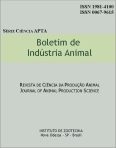Carcass characteristics of commercial Nellore bovines entired and castrated, created on pasture, and slaughtered in two different ages
Keywords:
carcass length, leg length, conformation, cushion thickness, carcass weightAbstract
Carcass characteristics of commercial Nellore bovines entired and castrated, with physiological maturity of four and six teeth, nearly 30 e 36 months of age, respectively, were studied. Data from thirty-two animals, created at pasture, were used. There was no interaction between sexual condition and ages for all studied variables. For leg length, castrated animals were superior to entire (93,8 vs 89,6cm), while for cushion thickness, animals with four teeth, nearly 30 months of age, were superior to six teeth that had around 36 months of age (24,6 vs 21,6 cm). No difference was observed for other measurements of carcass development. Commercial Nellore entired animals, are not identified as better muscular animals and younger animals are more efficient in musculature deposit in the hind, observed by the cushion thickness.
Downloads
Downloads
Published
Issue
Section
License
Os autores não serão remunerados pela publicação de trabalhos, pois devem abrir mão de seus direitos autorais em favor deste periódico. Por outro lado, os autores ficam autorizados a publicar seus artigos, simultaneamente, em repositórios da instituição de sua origem, desde que citada a fonte da publicação original seja Boletim de Indústria Animal. A revista se reserva o direito de efetuar, nos originais, alterações de ordem normativa, ortográfica e gramatical, com vistas a manter o padrão culto da língua e a credibilidade do veículo. Respeitará, no entanto, o estilo de escrever dos autores. Alterações, correções ou sugestões de ordem conceitual serão encaminhadas aos autores, quando necessário. Nesses casos, os artigos, depois de adequados, deverão ser submetidos a nova apreciação. As opiniões emitidas pelos autores dos artigos são de sua exclusiva responsabilidade. Todo o conteúdo deste periódico, exceto onde está identificado, está licenciado sob a Licença Creative Commons Attribution (CC-BY-NC). A condição BY implica que os licenciados podem copiar, distribuir, exibir e executar a obra e fazer trabalhos derivados com base em que só se dão o autor ou licenciante os créditos na forma especificada por estes. A cláusula NC significa que os licenciados podem copiar, distribuir, exibir e executar a obra e fazer trabalhos derivados com base apenas para fins não comerciais.













